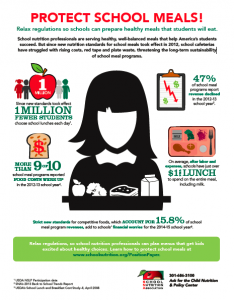Understanding why school nutritionists want to scrap the USDA’s nutrition standards takes some effort.
The question: Why is the School Nutrition Association (SNA)—the organization that represents the interests of “lunch ladies”—supporting Republican attempts to derail the nutrition standards?
The SNA has a long and honorable history of fighting for better nutrition for children, and it supported the 2010 Healthy Hunger-Free Kids Act—the one that gave USDA the authority to mandate healthier meals.
Jerry Hagstrom, who writes the daily Hagstrom Report, took a stab at explaining why SNA shifted position:
When the school-lunch program started, most schools cooked their own food. As the number of children participating in the school-lunch program grew, the need to provide more food led the schools to buy prepackaged, processed food, which led to the companies making those foods becoming big players within SNA.
Helena Bottemiller Evich of Politico adds to the explanation:
The story behind the school lunch flip-flop is a complicated web of lobbying change-ups, industry influence and partisan posturing inside the Beltway…Interviews with more than a dozen former and current SNA officials reveal a dramatic shift in SNA’s policy platform, and even more so, its approach: choosing to wage war on Capitol Hill — pitting the association against [Michelle] Obama and her team — instead of trying to win more concessions directly from the Department of Agriculture…[This] has sparked a civil war within the nutrition community and the association itself. Nineteen former SNA presidents wrote to appropriators last week urging them to reject calls for a waiver — a break in ranks that was painful but necessary, signers said.
She adds this critical piece of information:
Several former presidents of the organization said they are worried that food companies have influenced the group’s agenda over concerns that the nutrition standards for the $11 billion program will take a big bite out of sales of popular items like pizza and salty snacks…About half of the group’s $10 million operating budget comes from food industry members.
Kevin Concannon, USDA Undersecretary for Food, Nutrition and Consumer Services, told Jerry Hagstrom that the SNA’s current leadership is making a “serious mistake” is supporting members of Congress who want to block USDA’s standards. If the SNA lobbies for permanent blockage of the standards, he thinks they will be “playing with fire.” SNA, he said, is isolated on the issue. “The stakes are really high for the future of the country,” he said. “It is a battle worth waging.”
Is SNA isolated? Indeed it is. Here’s the list of organizations that support the new standards, compiled by the American Public Health Association.







